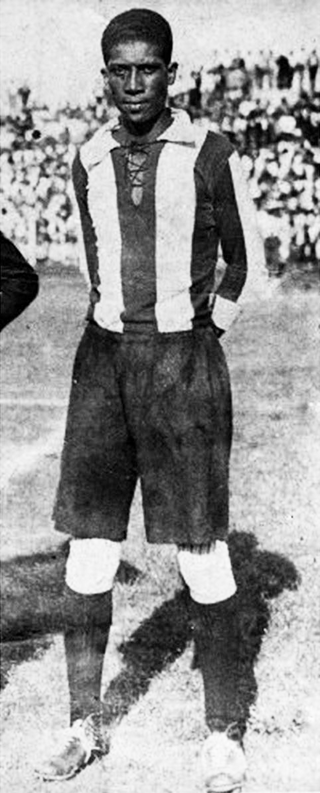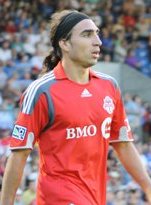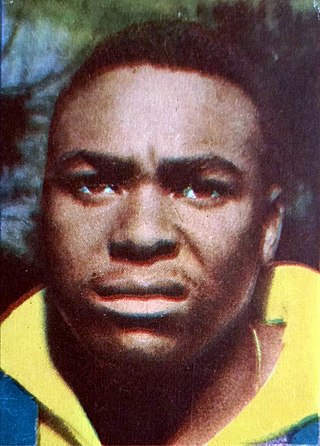
Teófilo Juan Cubillas Arizaga is a Peruvian former footballer who played as an attacking midfielder. He was selected as Peru's greatest ever player in an IFFHS poll, in which he was also included in the world's Top 50. He was renowned for his technique, shooting ability and free kick ability.

The Peru national football team, nicknamed La Bicolor, represents Peru in men's international football. The national team has been organised, since 1927, by the Peruvian Football Federation (FPF). The FPF constitutes one of the ten members of FIFA's South American Football Confederation (CONMEBOL). Peru has won the Copa América twice, and has qualified for the FIFA World Cup five times ; the team also participated in the 1936 Olympic football competition and has reached the semi-finals of the CONCACAF Gold Cup. The team plays most of its home matches at the Estadio Nacional in Lima, the country's capital.

Roberto Boninsegna is an Italian former professional footballer who mainly played as a forward. After retiring, he worked as a football manager. As a player, he played for the Italy national side at two World Cups, reaching the final in 1970.

José Paolo Guerrero Gonzáles is a Peruvian professional footballer who plays as a striker for Peruvian Primera División club Alianza Lima and the Peru national team.

José Macia, better known as Pepe, is a Brazilian former football player and manager. He is considered one of the greatest players in the history of Santos FC and one of the greatest left wingers of all time, being two-time World Champion in 1958 and 1962 and two-time World-Club Champion in 1962 and 1963 helping Santos FC defeat the iconic SL Benfica of Eusébio and the Milan of Cesare Maldini, Trapattoni, Rivera, Amarildo and Altafini in a best-of-three final.

The club is the first soccer representative of the first port of Peru, Callao, which laid the foundations for future Chalacos clubs, going from being a school club to being a professional club, gaining recognition, prestige and trust among fans of the Callao, from Lima and Peru, since today there are many clubs with the name of Atlético Chalaco, but only one is the original and traditional. [At present, Atlético Chalaco is called the "Historical Soccer Heritage of the Constitutional Province of Callao ".

Carlos Alejandro Villanueva Martínez was a Peruvian footballer who played for Alianza Lima and the Peru national football team. He is considered one of the most important Alianza strikers in the 1920s and 1930s.

Pedro Virgilio Rocha Franchetti was a Uruguayan footballer who played 52 games for the Uruguay national team between 1961 and 1974. Nicknamed "el Verdugo", he was a highly skillful midfielder and a prolific goalscorer, regarded by Pelé as "one of the 5 best players in the world". He was listed by the IFFHS as the 37th greatest South American player of the XXth century.

Pablo Vitti is an Argentine footballer who plays as striker. Vitti played for different clubs both in his country and abroad, including Ukraine, Canada, Mexico and Ecuador. He is known for his dribbling and finishing ability.

Hugo Alejandro Sotil Yerén is a Peruvian former professional football player. Nicknamed El Cholo, he played as a striker or midfielder. Together with Teófilo Cubillas and Héctor Chumpitaz, he was one of Peru's most recognized football players of the 1970s. He also was a popular player in Peru, and a biopic on his life was released in that decade. He was a member of the Peruvian team that won the 1975 Copa América and reached the quarterfinals in Mexico 1970 and Argentina 1978.

Antônio Wilson Vieira Honório, nicknamed Coutinho, was a Brazilian coach and footballer who played as a forward for Santos Futebol Clube, where he was a teammate and one of the best partners of Pelé, and became a member of the Brazil national team that won the 1962 FIFA World Cup. He is considered one of the greatest strikers in the history of Brazilian football with 368 goals in 457 matches even though he prematurely ended his football career before the age of 30 due to knee problems. His main virtues as a striker were coldness and precision in finishing, the ability to dribble in tight spaces and a keen awareness of team play, which allowed him to make several one-two passes with Pelé in the midst of opponent defenses. In Brazil, during his time as a player, he received the nickname "genius of the small area" many years before other great Brazilian striker Romario. Pelé himself declares that "Coutinho, within the area, was better than me. His coldness was something supernatural".
Johan Javier Fano Espinoza is a Peruvian football manager and former player who played as a forward.

Lionard Fernando Pajoy Ortiz is a Colombian professional footballer who plays as a striker for Alianza Universidad.

Félix Alberto Gallardo Mendoza was a Peruvian football player and manager who played as a forward. He is regarded as a renowned sprinter, possessing shooting power and an atypical physical display for Peruvian football. For years he was a renowned left wing of Sporting Cristal and the National Peruvian Team from where he launched strong shots with either of the two profiles. Because of his style of play, he was popularly known as the "Jet". He is considered one of the best Peruvian wingers of all time.

Teodoro "Lolo" Fernández Meyzán was a Peruvian professional footballer who played as forward. All his football work was carried out as a player of the Universitario de Deportes of the Peruvian First Division. He was champion, best player and top scorer in the 1939 Copa América. He is the top idol of Universitario de Deportes and Peruvian First Division.

Alberto Terry Arias-Schreiber, popularly known as "Toto," was a Peruvian footballer who played as an attacking midfielder for Universitario de Deportes, Sporting Cristal, and the Peru national football team. He is recognized as one of Peru's most important midfielders.
Football is the most popular sport in Peru. Football/soccer in Peru was introduced by British immigrants, Peruvians returning from Great Britain, and by English sailors in the later half of the 19th century during their frequent stops at the port of Callao, which at that point was considered one of the most important ports of the Pacific Ocean. According to the work entitled La Difusión del Fútbol en Lima, during the last decade of the 19th century, records show that sailors were known to practice sports such as football/soccer and played against teams made up of Englishmen, Peruvians, or a mix between Englishmen and Peruvians.

Juan Joya Cordero was a Peruvian association football player, recognized as one of Peru's most important strikers. He was a historic forward of the Club Atlético Peñarol of Uruguay in the 1960s, one of the best South American teams of the twentieth century. During his time with Club Atlético Peñarol, he won 6 Uruguayan league championships, two Copa Libertadores, two Intercontinental Cups, and one Intercontinental Champions' Supercup. He was considered one of the best wingers in the world in the 1960s, and remains one of the most famous Peruvian footballers of all time.

Raúl Mario Ruidíaz Misitich is a Peruvian professional footballer who plays as a striker for Major League Soccer club Seattle Sounders FC and the Peru national team.
Wilder José Cartagena Mendoza is a Peruvian footballer who plays as a defensive midfielder for Major League Soccer club Orlando City and the Peru national team.

















